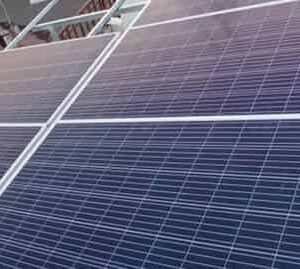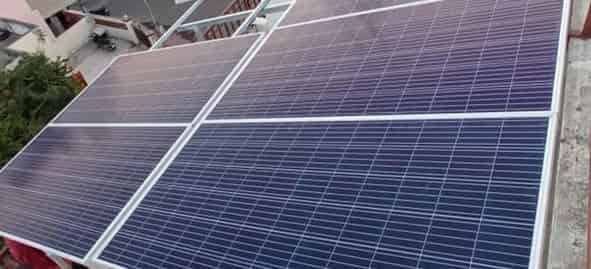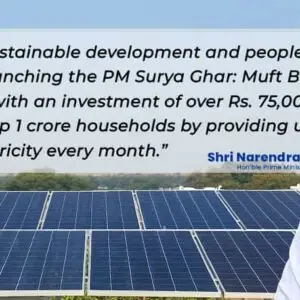No products in the cart.

Introduction
Solar energy is an excellent alternative to conventional electricity. It helps reduce electricity bills and supports environmental sustainability. The Indian government and various state governments are promoting solar energy through multiple schemes, including the Free Solar Panel Registration Scheme. This article provides a step-by-step guide to online registration and how to benefit from the scheme.

Table of Contents
Objective of the Free Solar Panel Scheme
The main goals of the solar energy scheme include:
- Promoting self-reliance in electricity generation
- Enhancing power availability in rural and urban areas
- Reducing electricity expenses
- Contributing to environmental conservation
To encourage solar panel installation, the government provides subsidies, making it more affordable and accessible.
Step-by-Step Solar Panel Registration Process
Step 1: Visit the Official Website
Go to the official website of the Ministry of New and Renewable Energy (MNRE) https://mnre.gov.in or your respective state energy department’s website. Look for the Solar Panel Scheme link on the homepage.
Step 2: Fill the Registration Form
Enter the required details, including:
- Name
- Address
- Contact Number
- Email ID
- Electricity Consumer Number (if applicable)
Step 3: Upload Necessary Documents
You need to upload the following documents:
- Identity Proof (Aadhaar Card, PAN Card)
- Copy of the Latest Electricity Bill
- Proof of Property Ownership (Registry or Rental Agreement)
Step 4: Submit the Application
Review the information and click the Submit button. Note down the registration number or application ID for future reference.
Step 5: Track Application Status
You can check your application status under the Track Application section on the website.

Eligibility Criteria for the Scheme
To apply for the Free Solar Panel Scheme, you must:
- Be an Indian citizen
- Own a house or property
- Have a valid electricity connection (domestic or commercial)
Additional Considerations:
- Income Category: Priority is given to Below Poverty Line (BPL) families.
- Space Availability: Must have a rooftop or open space for solar panel installation.
- Previous Subsidy: Applicants should not have availed of a solar subsidy before.
Subsidy Details and Distribution Process
Government Subsidy Rates
- 1-3 kW: 40% subsidy
- 4-10 kW: 20% subsidy
- Grid-connected systems: Additional benefits vary by state
How is the Subsidy Distributed?
- Once the application is approved, the beneficiary receives a subsidy approval letter.
- The subsidy amount is transferred directly to the beneficiary’s bank account.
- After installation and inspection, the final subsidy amount is released.
State-Specific Solar Panel Schemes
Each state has its own specific incentives:
Uttar Pradesh:
- Scheme Name: PM Kusum Yojana
- Subsidy: Up to 60%
- Priority given to farmers
Rajasthan:
- Rural Areas: Up to 50% subsidy
- Urban Areas: Up to 40% subsidy
Maharashtra:
- Equal benefits for urban and rural areas
- Discounts on grid-connected solar systems
Tamil Nadu:
- Free solar panels up to 3 kW
- Special discounts for industrial users
Technical Information About Solar Panels
Types of Solar Panels:
- Monocrystalline Panels: High efficiency, ideal for small spaces
- Polycrystalline Panels: Affordable, suitable for hot climates
- Thin-Film Panels: Lightweight and flexible, good for limited space
Capacity and Maintenance:
- 1 kW panel generates 4-6 units of electricity per day
- Regular cleaning and annual inspections are necessary
Support Services Under the Scheme
The government ensures complete assistance throughout the process:
- Free installation services by government-approved companies
- Only ISI-certified panels are used
- Five years of free maintenance post-installation
Things to Consider Before Installing Solar Panels
- Choose a location with maximum sunlight exposure
- Select the right panel capacity based on your energy needs
- Consult your state’s electricity board for scheme confirmation
- Keep track of updated information from local electricity offices
Long-Term Impact of the Scheme
- Reduces dependence on the national power grid
- Decreases greenhouse gas emissions
- Helps individuals become energy independent
- Boosts economic benefits by cutting electricity costs
Contact Information
For further details about Free Solar Panel Registration, contact:
- National Solar Energy Helpline: 1800-180-0005
- Email: support@mnre.gov.in
- Official Website: https://mnre.gov.in
Success Stories of Beneficiaries

Success Story 1: Ram Singh (Uttar Pradesh)
- Problem: Frequent power outages
- Solution: Enrolled under PM Kusum Yojana
- Result: Reduced electricity bill by 50%
Success Story 2: Anjali Devi (Rajasthan)
- Problem: High electricity costs
- Solution: Benefited from Rural Solar Scheme
- Result: Achieved complete energy independence

Environmental Benefits of Solar Energy
- Reduces greenhouse gas emissions: A single solar panel can cut 1.5 tons of CO2 emissions per year
- Clean energy alternative: Solar power replaces fossil fuels
- Unlimited renewable energy source
- Aids in climate change mitigation
Frequently Asked Questions (FAQs)
1. Who is eligible for the scheme?
All Indian citizens, whether in urban or rural areas, can apply.
2. Is there any registration fee?
No, registration is completely free.
3. How long does installation take?
After approval, installation is completed within 30-60 days.
4. How is the subsidy provided?
The subsidy amount is directly transferred to the beneficiary’s bank account.
Conclusion
The Free Solar Panel Scheme is an economically and environmentally beneficial initiative. If you wish to take advantage of this opportunity, register online today. Embrace solar energy and contribute to a sustainable future!
फ्री सोलर पैनल रजिस्ट्रेशन फॉर्म Online – पूरी जानकारी
Please note: This website is not an official one. It has no affiliation with the central or state government, or any government organization. The site solely provides information related to the PM Surya Ghar Yojana and other government schemes. To apply for any scheme, please visit the official website.






